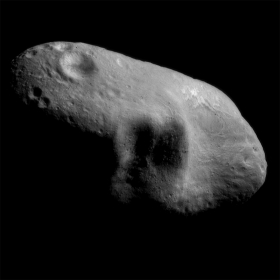Published January 26, 2010 02:01 PM
Asteroids and Their Impact

NASA's Wide field Infrared Survey Explorer, or WISE, has spotted its first never before seen near Earth asteroid, the first of hundreds it is expected to find during its mission to map the whole sky in infrared light. There is no danger of this newly discovered asteroid hitting the Earth. Since it formed over 4.5 billion years ago, Earth has been hit many times by asteroids and comets whose orbits bring them into the inner solar system. Some of these sites are well known such as Meteor Crater in Arizona as well as the theory that the extinction of the dinosaurs was caused by a such a collision. These objects, collectively known as near Earth Objects, still pose a danger to Earth today.
The near Earth object, designated 2010 AB78, was discovered by WISE
Jan. 12. The mission's sophisticated software picked out the moving
object against a background of stationary stars. As WISE circled Earth,
scanning the sky above, it observed the asteroid several times during a
period of one and a half days before the object moved beyond its view.
The asteroid is currently about 158 million kilometers (98 million
miles) from Earth. It is estimated to be roughly 1 kilometer (0.6 miles)
in diameter and circles the sun in an elliptical orbit tilted to the
plane of our solar system.
Near Earth objects are asteroids and comets with orbits that pass
relatively close to Earth's path around the sun.
The Chicxulub crater is an ancient impact crater buried underneath the
Yucatán Peninsula in Mexico. The crater is more than 180 kilometers (110
mi) in diameter, making the feature one of the largest confirmed impact
structures in the world; the impacting asteroid that formed the crater
was at least 10 km (6 mi) in diameter. It has been theorized by some
scientists that this is the event that triggered the extinction of the
dinosaurs.
In 1991 the U.S. Congress directed NASA to conduct workshops on how
potentially threatening asteroids could be detected, and how they could
be deflected or destroyed. In 1994 the House Committee on Science and
Technology directed NASA, in coordination with the DOD, to work with the
space agencies of other countries to identify and catalogue within 10
years the orbital characteristics of 90% of all comets and asteroids
larger than 1 km and in orbits that cross the orbit of Earth.
Following the 2003 NASA report from the near Earth Object Science
Definition Team, Congress went even further and in 2005 assigned NASA
the task of detecting 90% of near Earth objects with a size greater than
140 meters in diameter by the year 2020.
On January 14, the WISE mission began its official survey of the entire
sky in infrared light, one month after it rocketed into a polar orbit
around Earth from Vandenberg Air Force Base in California. By casting a
wide net, the mission will catch all sorts of cosmic objects, from
asteroids in our own solar system to galaxies billions of light years
away.
WISE is expected to find about 100,000 previously unknown asteroids in
our main asteroid belt, a rocky ring of debris between the orbits of
Mars and Jupiter. It will also spot hundreds of previously unseen near
Earth objects.
By observing infrared light, WISE will reveal the darkest members of the
near Earth object population. The mission will contribute important
information about asteroid and comet sizes. Visible light estimates of
an asteroid's size can be deceiving, because a small, light colored
space rock can look the same as a big, dark one. In infrared, however, a
big dark rock will give off more of a thermal, or infrared glow, and
reveal its true size. This size information will eventually give
researchers a better estimate of how often Earth can expect potentially
devastating impacts.
For further information: http://www.nasa.gov/mission_pages/WISE/main/index.html
or http://neo.jpl.nasa.gov/
2009. Copyright Environmental News Network To subscribe or visit go to: http://www.enn.com